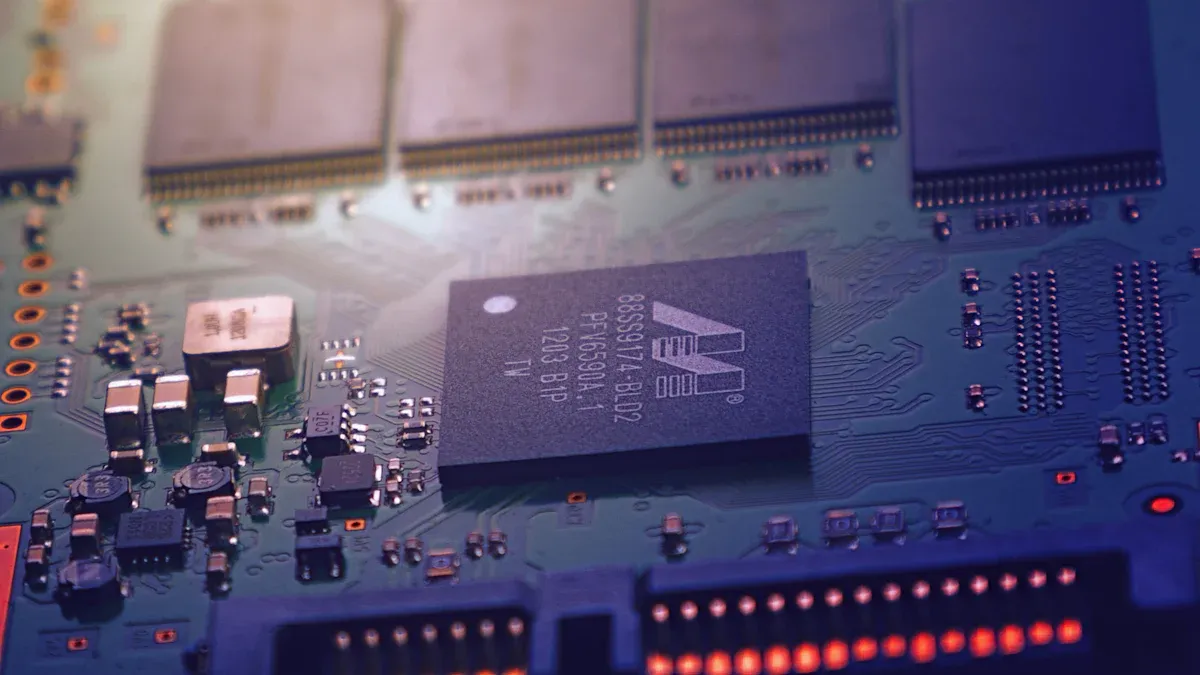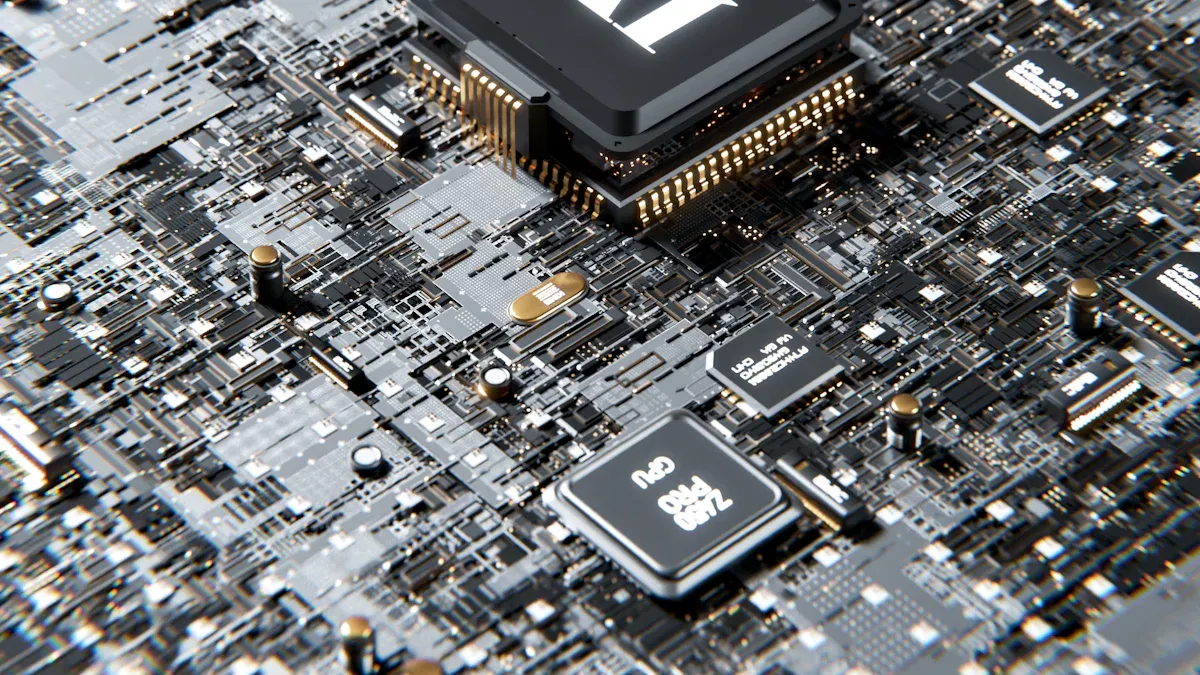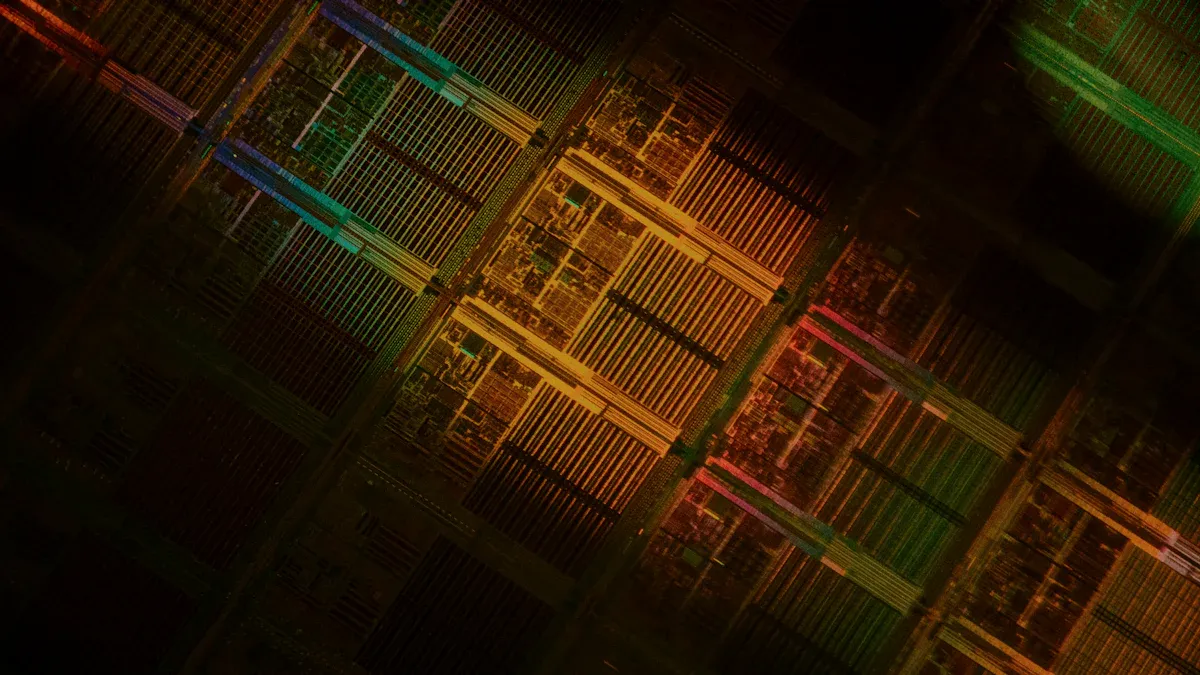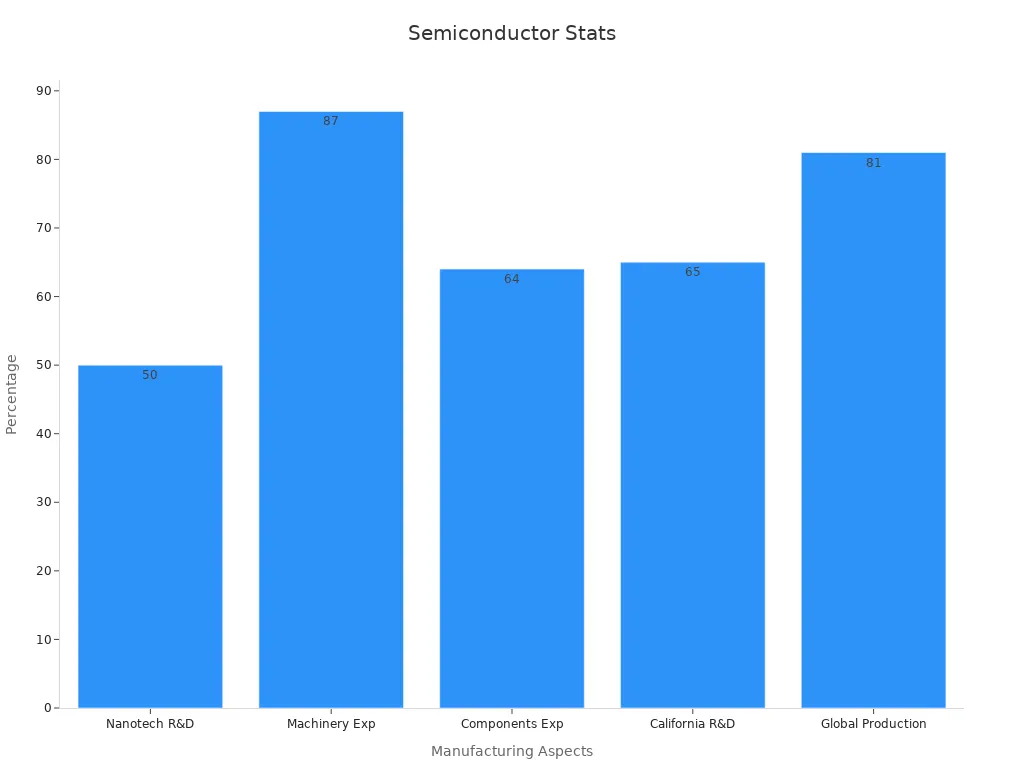What is a Computer Chip and How Does It Work

A computer chip, also called a microchip or integrated circuit, acts as the brain of electronic devices. It controls tasks by quickly switching tiny electrical signals on and off. This process lets the chip handle instructions, store data, and run programs. Devices like phones, cars, and home appliances rely on these chips to work smoothly.
Aspect | Details |
|---|---|
USD 57.3 billion | |
CAGR (2021-2031) | Approximately 10.6% |
Key Applications | Consumer Electronics, Automotive, Aerospace & Defense, Industrial |
Key Takeaways
A computer chip acts as the brain of electronic devices by processing information and managing tasks quickly and efficiently.
Chips contain millions or billions of tiny switches called transistors that control electrical signals to run programs and store data.
Silicon is the main material used to build chips, and advanced manufacturing steps create the tiny circuits that make chips powerful.
Different types of chips serve different purposes, such as CPUs for general tasks, GPUs for graphics and AI, and SoCs for mobile devices.
Chips power many everyday products and industries, driving innovation, improving efficiency, and supporting technologies like artificial intelligence.
What is a Computer Chip
Definition
A computer chip is a tiny piece of material that holds many electronic parts. People also call it a microchip or an integrated circuit. Scientists and engineers use the term "integrated circuit" because the chip combines many small parts, such as transistors and resistors, into one unit. Technical studies on advanced circuits, like graphene radio frequency receivers and memristive circuits, confirm that a computer chip is the same as a microchip or integrated circuit.
A global trade network analysis shows that integrated circuits are a key part of the chip industry. This research highlights that the chip acts as the "brain" of the information and manufacturing industries. The chip's role as a central part of modern technology is clear from its wide use in many devices.
A computer chip contains millions or even billions of tiny switches called transistors. These transistors control the flow of electricity and allow the chip to process information. For example, the first commercial chip, the Intel 4004 microprocessor from 1971, had 2,300 transistors. Today, modern chips like the Apple M1 Max have up to 114 billion transistors, each only a few nanometers wide. This huge increase in transistor count has made chips much faster and more powerful.
Note: The size of a transistor on a modern chip is about one-fourth the size of the smallest virus. This tiny size allows more transistors to fit on a single chip, making computers and devices more efficient.
Main Function
The main function of a computer chip is to process and manage information in electronic devices. The chip acts as the control center, handling tasks such as running programs, storing data, and managing signals. Each chip contains millions or billions of microscopic parts, including transistors, resistors, and capacitors. These parts work together to perform important jobs:
Power management: The chip controls how much power each part of the device uses.
Data processing: The chip reads, changes, and stores information.
Signal management: The chip sends and receives signals to other parts of the device.
Microprocessor chips, for example, contain tens of millions of circuit elements like SRAM cells, clocked memory elements, and logic gates. These elements process and execute instructions quickly and reliably. The mean time to failure (MTTF) for a single circuit element can reach a billion years, but because there are so many elements, the overall chip MTTF is only a few years. This shows both the complexity and the reliability challenges of modern chips.
Digital Signal Processing (DSP) chips show another main function. They perform simple math operations very quickly, which helps devices like cell phones and radios work better. By using software instead of extra hardware, DSP chips make devices smaller and more flexible.
Function | Description |
|---|---|
Power Management | Controls energy use in the device |
Data Processing | Handles reading, changing, and storing information |
Signal Management | Sends and receives signals to other device parts |
Instruction Execution | Runs programs and completes tasks |
A computer chip makes it possible for devices to work smoothly and efficiently. Without these chips, modern electronics would not function as people expect.
Chip Structure

Components
A computer chip contains many tiny parts that work together to process information. The main material used is silicon, which acts as a semiconductor. Silicon atoms form a strong crystal structure called a diamond cubic lattice. This structure gives silicon its special properties, making it perfect for controlling electricity. Engineers add small amounts of other elements, called dopants, to silicon. This process, known as doping, creates areas with extra electrons (n-type) or missing electrons (p-type). These areas help the chip control the flow of electric current.
To build a chip, manufacturers start with a large, pure silicon crystal called an ingot. They slice the ingot into thin wafers. On these wafers, they use advanced techniques like photolithography, etching, and doping to create the tiny circuits. Thin layers of materials, such as silicon dioxide, act as insulators or conductors. These layers separate and connect different parts of the chip. The finished chip contains millions or billions of tiny components, all packed into a space smaller than a fingernail.
Georgia Tech's research explains that chips include transistors, memory cells, and control units. Advanced packaging methods can connect several smaller chips, called chiplets, to boost performance and flexibility.
Transistors
Transistors are the most important building blocks inside a computer chip. Each transistor acts like a tiny switch that can turn electricity on or off. This switching action allows the chip to process digital information using binary code—ones and zeros. Modern chips use two main types of transistors: bipolar junction transistors (BJTs) and field-effect transistors (FETs). Most chips today use a special kind of FET called a MOSFET, which uses less power and can be made very small.
Aspect | Explanation | Technical Detail |
|---|---|---|
Transistor Function | Switches or amplifies electrical signals | |
Binary Representation | On = current flows (1), Off = no current (0) | Used in logic gates and memory cells |
Density | Millions to billions of transistors per chip | Enables fast, complex computations |
Innovation | 3D designs like FinFETs improve performance and energy use | Better current control, smaller size |
Transistors have changed a lot since their invention. Early chips used only a few transistors, but now a single chip can hold billions. New designs, such as 3D transistors, help chips run faster and use less energy. These advances make transistors the key to powerful and efficient computer chips.
How a Computer Chip Works
Binary Processing
A computer chip handles information using a system called binary processing. In this system, everything breaks down into two states: on and off. Engineers call these states "1" and "0." Each tiny switch inside the chip, known as a transistor, can either let electricity flow (on) or block it (off). By arranging millions or billions of these switches, the chip can represent numbers, letters, and instructions.
Logic gates play a key role in this process. These gates combine several binary signals to make decisions. For example, an AND gate only turns on if all its inputs are on. An OR gate turns on if at least one input is on. By linking many logic gates together, the chip can solve math problems, compare numbers, and follow instructions from software.
Tip: Every photo, song, or message on a device starts as a long string of 1s and 0s. The computer chip reads and changes these strings at lightning speed.
Clock Cycle
The clock cycle acts like a metronome for the computer chip. It sets the pace for every action inside the chip. Each tick of the clock tells the chip when to move to the next step. The clock cycle measures the time between two rising edges of a repeating clock signal. Faster clock cycles mean the chip can do more work in less time.
Researchers at the University of Maryland explain that the performance of a chip depends on three main factors: how many instructions it must run, how long each clock cycle lasts, and how many cycles each instruction needs. Not every instruction takes the same number of cycles. The average number of cycles per instruction depends on the mix of instructions, the way the chip is built, and how the software is written. For example, two computers might have different clock speeds and need different numbers of cycles for each instruction. The one with the shorter total execution time will finish tasks faster.
ScienceDirect describes the clock cycle as the heartbeat of digital systems. The clock frequency, which is the number of cycles per second, shows how quickly the chip can work. Higher frequencies allow the chip to process more instructions every second. However, the chip must also meet timing rules, such as setup and hold times for its registers. These rules make sure the chip works correctly at high speeds.
Performance metrics like MIPS (millions of instructions per second) and MFLOPS (millions of floating-point operations per second) help measure how well a chip performs. Designers try to reduce the clock cycle time to boost speed. They also use methods like pipelining and multiprocessing to let the chip handle more tasks at once. The type of instruction set and the way the software is written can also change how many cycles each instruction needs.
Term | Meaning |
|---|---|
Clock Cycle | The time between two ticks of the chip's clock signal |
Clock Frequency | How many cycles happen each second (measured in Hertz, Hz) |
Logic Gate | A circuit that makes decisions using binary signals |
MIPS/MFLOPS | Ways to measure how many instructions or calculations a chip can do |
Note: The clock cycle controls the rhythm of every operation inside the chip. Faster cycles mean more instructions get done in less time, but the chip must stay within safe timing limits to avoid errors.
Materials and Manufacturing

Silicon
Silicon forms the foundation of almost every modern chip. Manufacturers choose silicon because it acts as a semiconductor, meaning it can control electricity in special ways. To make chips, companies use high-purity silicon, often reaching a purity level of 99.9999999%. This level of purity ensures that chips work reliably and last longer.
Aspect | Description |
|---|---|
Silicon Wafer Types | Polished and epitaxial wafers made from electronic-grade polysilicon |
Manufacturing Process | Crystal growth (Czochralski method), slicing, grinding, etching, polishing, cleaning |
Key Quality Factors | Electrical properties, surface smoothness, impurity control, micro-defect management |
Industry Trends | Larger wafer sizes (150 mm to 300 mm), higher purity, fewer defects, more automation |
Scientists use advanced tools like Gas Chromatography and Mass Spectrometry to check for even the smallest impurities. These tools can find a single unwanted atom among 100 million silicon atoms. Companies focus on removing defects and controlling oxygen levels to improve chip performance. The industry continues to grow, with global silicon wafer shipments increasing by almost 14% in 2021.
Manufacturing Steps
Chip manufacturing involves many precise steps. Each stage requires careful control to make sure the final product meets strict quality standards.
Wafer Fabrication: Workers slice pure silicon ingots into thin wafers. Each wafer becomes the base for hundreds of chips.
Photolithography and Etching: Machines use light to draw tiny patterns on the wafer. Etching removes material to form the chip’s circuits. Some chips have up to 175 layers, making this step very complex.
Ion Implantation: Engineers shoot ions into the wafer to change its electrical properties. Heat treatment activates these changes, helping transistors work properly.
Deposition: Special machines add thin layers of materials using methods like Chemical Vapor Deposition. These layers build up the chip’s structure.
Quality Control: Automated systems inspect every step. They use optical tools and statistical checks to catch defects early.
AI Integration: Artificial intelligence helps spot problems faster and improves the accuracy of inspections.
Packaging: After cutting the wafer into individual chips, workers mount them on substrates and add heat spreaders to keep them cool.

The CHIPS Metrology Program supports these steps by providing new ways to measure purity and process quality. This helps the industry keep improving chip performance and reliability.
Types and Uses
Chip Types
Many types of chips exist, each designed for specific tasks. The main categories include:
Central Processing Units (CPUs): These chips handle general tasks in computers and servers. They manage instructions and run software.
Graphics Processing Units (GPUs): GPUs process images and video. They also power artificial intelligence and deep learning tasks.
Application-Specific Integrated Circuits (ASICs): Engineers design ASICs for one job, such as running a specific algorithm or managing a network.
Field-Programmable Gate Arrays (FPGAs): FPGAs can be reprogrammed after manufacturing. They offer flexibility for testing and custom uses.
System-on-Chip (SoC): SoCs combine several functions, like CPU, GPU, and memory, on a single chip. Smartphones and tablets often use SoCs.
Market research groups chips by type, processing method, technology, and application. Studies compare chip performance using benchmarks like time to complete tasks, quality of results, and support for customer needs. For example, benchmark tests show that GPUs often run deep learning models much faster than CPUs. ASICs, such as Google’s TPU, can outperform GPUs in some AI tasks. FPGAs offer a balance between speed and flexibility.
Chip Type | Main Use | Performance Highlights |
|---|---|---|
CPU | General computing | Good for many tasks |
GPU | Graphics, AI | Up to 1000x faster than CPUs in AI |
ASIC | Specialized tasks | Most efficient for single applications |
FPGA | Custom logic | Flexible, reprogrammable |
SoC | Mobile devices | Combines many functions |
Real-World Applications
Chips power many industries and everyday products. Companies use AI chips to speed up testing, cut costs, and improve quality. For example, NVIDIA uses AI to reduce chip testing time by half. Intel relies on AI for automatic defect detection, which lowers expenses. TSMC uses AI to predict demand and manage inventory, saving money and improving production speed.
Lean manufacturing with chips helps factories reduce lead times by up to 90% and cut defects by half. These improvements boost profits and make products more reliable.
Taiwan’s semiconductor industry shows how chips can drive economic growth. The government supported technology learning and innovation, helping local companies become global leaders. This strategy led to better products, faster development, and strong brand value.
Chips also help with logistics, risk management, and sustainability. Companies use AI to plan shipments, avoid delays, and reduce waste. These advances make industries more efficient and help protect the environment.
A computer chip powers many devices people use every day. These chips process information, manage energy, and help technology run smoothly. The global market for chips shows strong growth, with new types and uses appearing each year.
Aspect | Key Insights |
|---|---|
Market Size 2024 | |
Growth Rate | 10.7% CAGR (2024-2034) |
Main Applications | AI, graphics, networking |
Chips remain essential for digital transformation and innovation. People can appreciate how these tiny devices shape the modern world.
FAQ
What is the difference between a CPU and a GPU?
A CPU handles general tasks and runs most programs. A GPU processes images and graphics. Many devices use both chips to work faster and more efficiently.
How small is a computer chip?
Most chips are smaller than a fingernail. Some chips measure only a few millimeters across. Despite their size, they can hold billions of tiny parts.
Why do chips get hot during use?
Chips get hot because electricity flows through millions of transistors. This movement creates heat. Devices use fans or heat sinks to keep chips cool.
Can a computer work without a chip?
No, a computer cannot work without a chip. The chip acts as the brain. It processes information and controls every part of the computer.
Tip: Always keep your device cool to help the chip last longer.
See Also
Understanding Communication Chips And Their Functional Mechanisms
A Complete Guide To Power Supply Chips And Operation
Exploring MCU Microcontroller Chips And Their Working Principles
